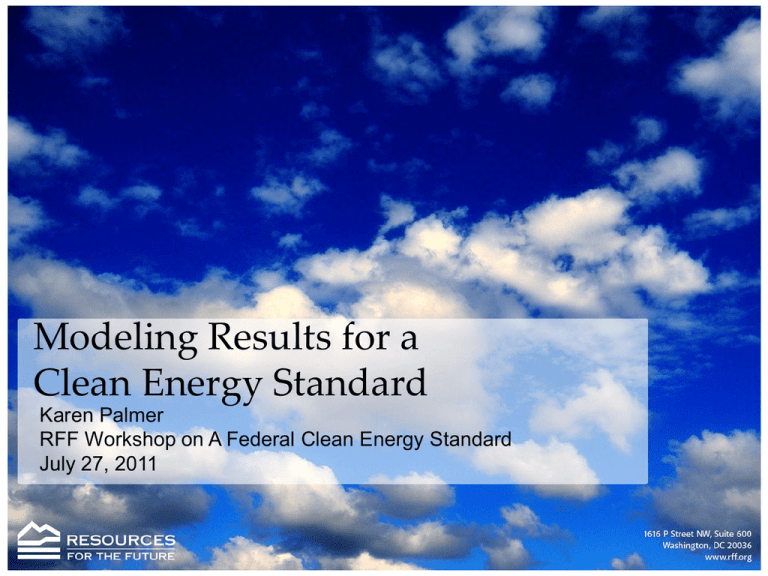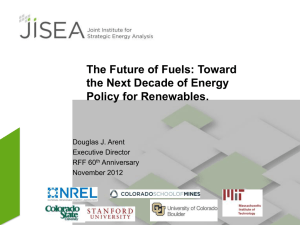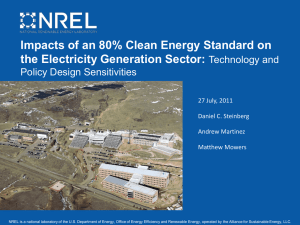Modeling Results for a Clean Energy Standard Karen Palmer
advertisement

Modeling Results for a Clean Energy Standard Karen Palmer RFF Workshop on A Federal Clean Energy Standard July 27, 2011 What to expect from a CES • How much does the CES policy reduce CO2 emissions? • What are the effects on the mix of generation technologies and fuels? • How does the policy affect national electricity price? • How do selected design parameters affect these results? • • Treatment of existing nuclear and hydro Level of the Alternative Compliance Payment (ACP) Policies Evaluated • Baseline • Core CES (Core) – – – – – – – – – Goal of 80% Clean Energy by 2035 Clean energy credit (CEC) trading but no banking No credits for existing nuclear and hydro No credits for energy efficiency Full credit for renewables and incremental nuclear Natural gas combined cycle awarded 0.5 credits Partial credits for coal with CCS All utilities must comply No Alternate Compliance Payment (ACP) • Credit Existing Nuclear and Hydro (CreditNH) • Core CES with varying ACP levels ($15 - $55 per CEC) Preview of the bottom lines The Core CES results in • a substantial 30% reduction in cumulative CO2 emissions from the electricity sector. • an increase in generation from broad set of clean generators. • an 11% increase in national electricity price by 2035. • Crediting existing hydro and nukes does not affect emissions outcomes but leads to higher electricity price. • Imposing a positive ACP will lower costs to consumers, generate government revenue, and reduce environmental gains. How much does a CES reduce CO2? 3.0 Billions of Tons 2.5 2.0 1.5 1.0 0.5 0.0 2010 2015 2020 BL 2025 Core 2030 2035 Generation Mix in 2035 5000 4500 Billion kWH 4000 Other 3500 Biomass 3000 Wind Hydro 2500 Nuclear 2000 Nat Gas 1500 IGCC Coal Steam Coal 1000 500 0 BL Core National Average Electricity Price 120 $ per MWh 100 80 60 40 20 0 2010 2015 2020 2025 BL Core 2030 2035 Effect of crediting existing hydro and nuclear • Same cumulative CO2 emissions reductions. • Small increase in nuclear generation at existing units at the expense of natural gas and wind. • Larger increase in national electricity price (15% in 2035). Clean Energy Credit Prices 80 70 60 50 40 30 20 10 0 2010 2015 ACP15 2020 ACP30 2025 ACP45 ACP55 2030 NoACP 2035 CO2 Reductions vary with ACP levels 3.0 Billions of Tons 2.5 2.0 1.5 1.0 0.5 0.0 2010 2015 BL ACP15 2020 ACP30 2025 ACP45 2030 ACP55 2035 NoACP Discounted Value of ACP Revenue NPV Federal ACP Revenue (B$) Billion $ 80 60 40 20 0 ACP15 ACP30 ACP45 ACP55 ACP and Electricity Price 120 115 $ per MWh 110 105 100 95 90 85 80 2010 2015 BL ACP15 2020 ACP30 2025 ACP45 2030 ACP55 NoACP 2035 Conclusions • Cumulative CO2 emissions are reduced by 30% with Core CES; less with binding ACP. • CES benefits broad mix of clean technologies. • National electricity price rises by just over 10 percent in 2035 with Core CES. • Electricity price effects depend on treatment of existing nuclear and hydro and on level of the ACP. • More analysis is needed to inform tradeoffs inherent in CES policy design. For more information see: Clean Energy Standards for Electricity: Policy Design Implications for Emissions, Supply, Prices and Regions by Anthony Paul, Karen Palmer and Matt Woerman Available at www.rff.org/centers/ climate_and_electricity_policy/Pages/ Renewable_and_Clean_Energy_Resource_Library. aspx








